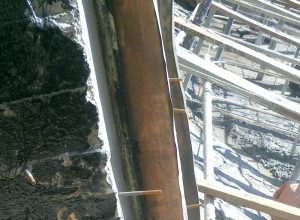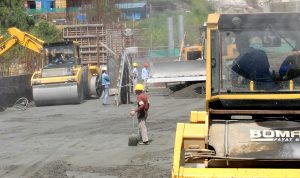Use of a concrete pump is prevalent in almost every concrete construction nowadays. Pumping fresh concrete using a hydraulic piston pump and steel pipeline was introduces in 1933 in America. During the time, the method was developed and improved for pumping different types of concretes, reduce pumping time, and pump further distances.
The principle behind concrete pumps
Concrete pumps use the twin-cylinder hydraulic piston technology. When the hopper is loaded, one piston will draw the concrete and push through the steel pipeline. In the meantime, other piston draws concrete from the hopper and pushes after the first piston. A valve determines the pushing cylinder and concrete drawing cylinder.
Types of concrete pumps.
The conventional categorization of concrete pump is,
- Stationary concrete pumps
- Mobile concrete pumps (truck-mounted pumps)
Stationary concrete pumps
These are electricity or fuel-powered pumps that can transport by toeing or loaded on a truck. It is the site engineer’s duty to plan & prepare the pipeline and pump location beforehand. That will allow smooth pumping operation with few pipe works. The advantage of the stationary pump is it has a wide range of pressure capacities. When it comes to high rise building construction, this pressure capacity is much essential.
Mobile concrete pumps/Concrete placing boom
These are truck-mounted concrete pumps. You can find slightly different arrangements of truck-mounted pumps. Concrete pump is mounted on the truck, making it easier to transport. The main advantage of using a mobile concrete pump is its easy maneuverability. Boom pumps cost 150 to 200 dollars per hour, which is slightly expensive than the stationary pumps. But the permanent pipeline attached to the boom will give you a definite placement advantage.
When placing with pump cars, you can reduce the scaffolding works for steel pipes. It will be a great advantage because the jerking action can cause support failures. Concrete can be delivered to the exact point with this type of pump when compared to a stationary pump with separate pipelines. Usually, the pump cars have 4-inch diameter pipes. The boom range varies between 20 to 70 meters in length.
How to select a suitable pump
There are a few points you should consider before selecting the concrete pump for your wok.
Check mix proportion characteristics
Increasing paste content and slump will allow smooth operation. Adding fly ash is an economical way of improving pumpability. However, the effect on compressive strength should calculate separately for fly ash use.
Select location & Pipeline setup
Yes, if you want to concrete a five-storied building, you should arrange a concrete pump that has enough pressure capacity. Likewise, the horizontal distance, the number of bends, and pipe diameters will add additional pressure requirements.
The site engineer has to select a suitable place for the pump. This place should have enough accessibility, ventilation, and lighting conditions. If you are using a pump car, it should place to cover the maximum area in a single time.
Use Nomograph
Nomograph is using to calculate the required pressure capacity of the concrete pump. It incorporates factors like discharge, slump, pipeline length to calculate the needed pressure. Use ACI nomograph to calculate the required pump pressure.
Steps to follow,
1. Select placement capacity according to the site requirement
2. Draw a horizontal line from the discharge rate and find the point that intersects the available steel pipe diameter

3. Then, draw a vertical line from that point and reach the corresponding pipeline length

4. Draw another horizontal line from pipe length intersecting point and continue up to the slump value sector.

5. Find the pressure according to the available slump at site

Now you have the pressure required for a basic setup. It should adjust according to modifications in the pipeline and elevation differences
- Add 145 psi for discharge less than 55 cu yd/hr
- Increase by 220 psi for discharge greater than 55 cu yd/hr
- Add 11 psi for every 10 feet of vertical go
- Include another 15 psi for every 90° bend and 7 psi for each 45° bend
- Add 22 psi for every 10 feet of rubber pipe length
- Sum up all and add 10% for average pressure loss
Safety
Both the safety of the pump and the operator should consider here.
- First, find a suitable well lit place for the pump. Proper ventilation is a must!
- Always watch out for power lines above the working area
- Select a well trained and experienced operator
- If you are using a pump car, the operator should have good eyesight to read the hand signals
- Use signalers, flags, lights and walky-talkies for communication
- Never increase the pressure during a blockage
- Fill the hopper at the end of each truck and pump small amounts to avoid hardening until the next truck reach the site
- Consider the weights and the jerk of the pipeline, prepare enough supports
- Maintain necessary records about the pour
- Batching time
- Placing time
- Placement location
- Slump & temperature etc
- Control the noise during the pour
- Repair and maintain the pumps
- Use cleaning sponge ball to washout all concrete in the line




Thanks for the tip that a mobile concrete pump is easier to transport. Due to some constraints, I will be have access to less construction workers for a new home that I’m planning to start to get built later this year, making the setting of the foundation quite tricky. Perhaps allotting some budget for concrete pumping services would help in speeding up the process.
My dad would like to transfer some of his liquid concrete, which is why he’s already looking for a pumping service that will be able to do that. Well, thank you for stating here that there are two types of concrete pumps, such as the stationary and mobile pump. I’m glad that you were also able to share here that the latter is easier to maneuver.